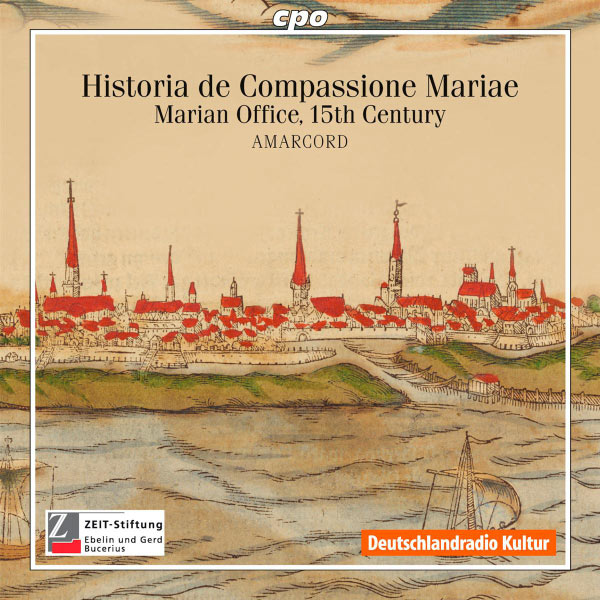
Streaming ilimitado
Escuche este álbum ahora en alta calidad en nuestras apps
Comenzar mi periodo de prueba gratis y escuchar este álbumDisfrute de este álbum en las apps Qobuz con sususcripción
SuscribirDisfrute de este álbum en las apps Qobuz con sususcripción
Idioma disponible: inglés
The packaging for this release telegraphs rather than indicates its contents, which are of interest mostly to chant enthusiasts and specialists but for that group are likely to be quite intriguing and unusual. The unusual quality resides less in the fact that the music contains a set of 15th century Office chants from a mass in honor of Mary than in their geographical origin: the music comes from Hamburg, pictured on the cover with its city wall and surrounding moat. Polyphony was slow to reach northern Germany, except in the hands of keyboardists, who sometimes played in alternation with chant singers, and the medieval chant from this part of Europe remains all but unknown. On this album there are only plainchants, taken from a recently discovered and edited manuscript and performed smoothly by the five-voice German a cappella group Amarcord. There are chants for three Nocturn Offices, plus an opening Invitatorium. The music doesn't match chants from earlier repertories or those from other parts of Europe and was in all likelihood newly composed. Its use of Latin is unusual (the extensive notes by Viacheslav Kartsovnik refer to "German chant dialect"), and the texts, too, are original; Kartsovnik suggests that they resemble German secular poetry of the era. The general listener can get a bit of this. Consider the third responsory from the first Nocturn, Quis dabit capiti meo (track 8); Mary's initial question, "Who will give water for my head and a fount of tears for my eyes?," is not an image from the classical body of chant. The notation includes no indication of rhythm, which is varied by the singers apparently on a hunch; Kartsovnik writes merely that "the refined design of the melodies by itself already presupposes a sublime treatment of the rhythm as well." This deserves a bit more explication, but the whole question of chant rhythm remains completely open, and the performances are elegantly reverential and closely driven by the texts. French speakers should note that although they get Kartsovnik's notes, the chant texts are given only in Latin, German, and English.
© TiVo
Está escuchando muestras.
Escuche más de 100 millones de pistas con un plan de streaming ilimitado.
Escuche esta playlist y más de 100 millones de pistas con nuestros planes de streaming ilimitado.
Desde $ 16.190,00/mes

Intonatio: Domine, labia mea aperies [15th century]
Amarcord Ensemble, Ensemble
2011 CPO 2011 CPO
Invitatorium: Christum regem adoremus [15th century]
Amarcord Ensemble, Ensemble
2011 CPO 2011 CPO
Historia de Compassione Gloriosissimae Virginis Mariae [Marian Office, Hamburg, 15th Century]
Amarcord Ensemble, Ensemble
2011 CPO 2011 CPO
Amarcord Ensemble, Ensemble
2011 CPO 2011 CPO
Amarcord Ensemble, Ensemble
2011 CPO 2011 CPO
Amarcord Ensemble, Ensemble
2011 CPO 2011 CPO
Amarcord Ensemble, Ensemble
2011 CPO 2011 CPO
Amarcord Ensemble, Ensemble
2011 CPO 2011 CPO
Amarcord Ensemble, Ensemble
2011 CPO 2011 CPO
Amarcord Ensemble, Ensemble
2011 CPO 2011 CPO
Amarcord Ensemble, Ensemble
2011 CPO 2011 CPO
Amarcord Ensemble, Ensemble
2011 CPO 2011 CPO
Amarcord Ensemble, Ensemble
2011 CPO 2011 CPO
Amarcord Ensemble, Ensemble
2011 CPO 2011 CPO
Amarcord Ensemble, Ensemble
2011 CPO 2011 CPO
Amarcord Ensemble, Ensemble
2011 CPO 2011 CPO
Amarcord Ensemble, Ensemble
2011 CPO 2011 CPO
Amarcord Ensemble, Ensemble
2011 CPO 2011 CPO
Amarcord Ensemble, Ensemble
2011 CPO 2011 CPO
Amarcord Ensemble, Ensemble
2011 CPO 2011 CPO
Presentación del Álbum
The packaging for this release telegraphs rather than indicates its contents, which are of interest mostly to chant enthusiasts and specialists but for that group are likely to be quite intriguing and unusual. The unusual quality resides less in the fact that the music contains a set of 15th century Office chants from a mass in honor of Mary than in their geographical origin: the music comes from Hamburg, pictured on the cover with its city wall and surrounding moat. Polyphony was slow to reach northern Germany, except in the hands of keyboardists, who sometimes played in alternation with chant singers, and the medieval chant from this part of Europe remains all but unknown. On this album there are only plainchants, taken from a recently discovered and edited manuscript and performed smoothly by the five-voice German a cappella group Amarcord. There are chants for three Nocturn Offices, plus an opening Invitatorium. The music doesn't match chants from earlier repertories or those from other parts of Europe and was in all likelihood newly composed. Its use of Latin is unusual (the extensive notes by Viacheslav Kartsovnik refer to "German chant dialect"), and the texts, too, are original; Kartsovnik suggests that they resemble German secular poetry of the era. The general listener can get a bit of this. Consider the third responsory from the first Nocturn, Quis dabit capiti meo (track 8); Mary's initial question, "Who will give water for my head and a fount of tears for my eyes?," is not an image from the classical body of chant. The notation includes no indication of rhythm, which is varied by the singers apparently on a hunch; Kartsovnik writes merely that "the refined design of the melodies by itself already presupposes a sublime treatment of the rhythm as well." This deserves a bit more explication, but the whole question of chant rhythm remains completely open, and the performances are elegantly reverential and closely driven by the texts. French speakers should note that although they get Kartsovnik's notes, the chant texts are given only in Latin, German, and English.
© TiVo
Acerca del álbum
- 1 disco(s) - 20 pista(s)
- Duración total: 00:57:38
- 1 Libreto digital
- Artistas principales: Amarcord Ensemble
- Compositor: Anonymous
- Sello: CPO
- Género Clásica
2011 CPO 2011 CPO
Mejorar la información del álbum
